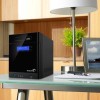Seagate Business Storage 4-Bay NAS Seagate Business Storage 1-Bay, 2-Bay, and - Page 36
I can’t open NAS Manager., I can’t access a shared folder. - volume failed
 |
View all Seagate Business Storage 4-Bay NAS manuals
Add to My Manuals
Save this manual to your list of manuals |
Page 36 highlights
Solving Problems Common Problems and Solutions I can't open NAS Manager. Check that the NAS is powered on and connected to the network. Run NAS Discovery and try to reconnect with the server, then launch NAS Manager. I can't log in to NAS Manager. Ensure that you are using a valid user name and password. Remember that user names and passwords are case-sensitive. I can't access a shared folder. • Ensure that you have access to that shared folder. • Ensure that you are using a valid user name and password. Remember that user names and passwords are case-sensitive. • The volume that contains the share may be degraded because of a disk drive error or failure. Check the status of your server's disk drives; see Chapter 5 "Monitoring and Managing Your Seagate® NAS" on page 27 for more information. I can't access a file on a shared folder. • Ensure that you are allowed access to that file. • The volume that contains the share may be degraded because of a disk drive error or failure. Check the status of your server's disk drives; see Chapter 5 "Monitoring and Managing Your Seagate® NAS" on page 27 for more information. I can't store any more files on a shared volume because its volume is full. • Consider removing some of the files currently stored on the NAS. A firmware upgrade failed. Try to upgrade the firmware manually. For further assistance, contact Seagate Support at www.seagate.com/support A volume is in degraded mode. A disk drive may have failed. For further assistance, contact Seagate Support at www.seagate.com/support I can't get streaming music from the Seagate NAS. • Ensure that you have iTunes installed on your computer. • Ensure that you are using a computer that's connected to the local network. • Ensure that you have access to the shared folder where music files are stored. Seagate Business Storage NAS Administrator Guide 36















